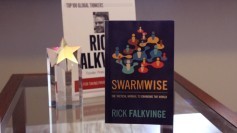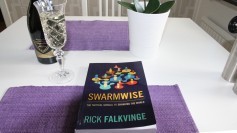Rick Falkvinge's Blog, page 22
August 8, 2013
Would Anti-LGBT Russia Have Given Asylum To Bradley Manning?

Reflections – Zacqary Adam Green: It’s a very interesting time in the news for Russia. On the one hand, they’re giving asylum to a man who blew the whistle on American mass surveillance. On the other hand, they just passed a law that’s grounds to throw the other big American whistleblower into a different sort of asylum. Where to begin?
How Russia might treat the two whistleblowers differently is just one thing that comes to mind. Edward Snowden’s presumably straight and cisgendered, whereas Bradley Manning was at one point a gay man, probably now identifies as female (and may or may not label herself straight), but is in any case the kind of person who would be persecuted under Russian law. Manning came first, and Snowden learned from Manning that he should run from the US. Had it been the other way around, Manning probably wouldn’t have Russia as an option.
But that’s just a hook to get us thinking about this whole situation. It’s odd timing to have Russia both gaining and losing human rights high ground against the US. They took in a man persecuted for revealing abuses of the right to privacy, while at the same time persecuting their own people for loving each other.
Of course, neither government actually has any moral high ground. The Kremlin has done, and still does, its fair share of invading privacy. I’m sure they would kill to have the kinds of capabilities the NSA has. Across the Pacific, Washington is only just now — kicking and screaming — barely starting to give a crap about LGBT people. That is, at least the ones who are fortunate enough to be considering marriage; poor LGBT people in the US have disproportionate issues with homelessness, mental illness, and sexual abuse that are being completely ignored.
This is all pure realpolitik: Russia tries to make the US look bad by protecting Snowden, the US returns the favor by fanning the flames of righteous indignation about Russia’s anti-gay laws as they prepare to host the Olympics. Both objectively righteous things to do, done for cynical reasons. It’s a war of culture and diplomatic clout, back and forth, over and over again as they try to gain more market share over the planet.
The truth is, all governments are bastards. Every government throws stones around its glass house. We can be thankful that Russia gave asylum to a whistleblower in order to spite the US. We can be thankful that American politicians have to cater to the LGBT base in order to get elected so they can rake in the bribes from lobbyists. But that doesn’t make either of them the “good guy.”
Although, if you think Russia’s bad for LGBT people, just imagine what could be done by a country that’s collecting every email ever written. I’m very happy that I have the right to marry my boyfriend, let alone that I can walk down the street holding his hand without getting beaten to death by an angry mob. I also know how precarious that is. One crisis, plus one loudmouth naming homosexuality as a scapegoat, could throw the United States back into the 1950s. Except this time, anybody at the NSA could type a few terms into a search box, and find all of the people who had ever posted to the Men Seeking Men section of Craigslist back when it was legal.
I am thankful that the Kremlin doesn’t have that capability. I am thankful that they don’t have the political capital with Washington to ask if they can borrow the data that the NSA has inevitably collected on Russian citizens. It would be genocide.
But my government does have that capability. All they have to do is develop the will to persecute LGBT people again, and I’ll have a black bag over my head by next Friday.

August 1, 2013
Swarmwise – The Tactical Manual To Changing The World. Chapter Seven.

Swarm Management: Following a high-profile event, your swarm just tripled in size in a week. You have twenty thousand new activists — new colleagues — that are all waiting for instructions from you, personally. They’re waiting for instructions from you because your name is the only one they know of. There are no MBA classes on how to handle this situation: those people talk about the challenges you encounter when growing by more than 10 percent a year. This is how you handle 200 percent growth in a week.
Swarmwise chapters – one chapter per month
1. Understanding The Swarm
2. Launching Your Swarm
3. Getting Your Swarm Organized: Herding Cats
4. Control The Vision, But Never The Message
5. Keep Everybody’s Eyes On Target, And Paint It Red Daily (this chapter)
6. Screw Democracy, We’re On A Mission From God
7. Surviving Growth Unlike Anything The MBAs Have Seen (this chapter)
8. Using Social Dynamics To Their Potential (Sep 1)
9. Managing Oldmedia (Oct 1)
10. Beyond Success (Nov 1)
The whole book is available for purchase from Amazon (US, UK) or for download as PDF.
On May 31, 2006, the Swedish police conducted a vastly overforceful raid against the Pirate Bay, creating tons of collateral damage and constitutional violations. Amid the protests, the Pirate Party tripled in member size, from the nascent 2,200 to the less-nascent 6,600 in a week. If you were looking at the member count graphs, it was as if the pilot of the graph pen had just pulled the stick backward and gone vertical. We called this a verticality and imagined it typically only happens once — a miracle-type event.
(We would have more than tripled if our servers had been able to handle the influx of new members. They had never been tested for this kind of load.)
On April 17, 2009, the verdict against the two operators of the Pirate Bay, its media spokesperson, and a fourth unrelated person was issued. It was seen as a gross miscarriage of justice. Amid the protests, the Pirate Party tripled in member count again, from 14,400 to becoming the third-largest Swedish party with 42,000 members in a week. The party had just had its second verticality.
Getting 20,000 new colleagues and activists in a week isn’t a pipe dream. It happens. Quite rarely, but it does happen. You need to be prepared for it.
BROADCASTING AND MAINTAINING VALUES
Common organizational practice holds that you should write down your organization’s values. This is not enough in a fast-growing swarm; you need to do three more things.
A values document is usually part of or joined with a corporate mission statement, and is one of many write-only documents (meaning that they are never actually read by anyone) in a typical organization, along with environmental policy, diversity policy, and laundry schedule. (To be honest, the laundry schedule may not belong on the list, as it is typically read once in a while.) However, in a swarm organization, the organizational culture cannot be communicated from person to person as the organization grows — it must be actively communicated centrally, and repeatedly communicated as new people keep joining.
Let’s take a look at a sample values document — this one is, again, from the Pirate Party, so you will note that there is mention of a General Assembly, which probably won’t be present in a nonpolitical swarm:
A SAMPLE VALUES DOCUMENT
Our organization is built on three different pillars: swarm work, traditional NGO structures, and a hierarchical top-down structure that distributes resources to support the swarm. These are roughly equally important, but fill completely different needs: the traditional NGO structure only resides at the General Assembly and the party board level, for the party’s legal foundation as an nonprofit organization; the hierarchic work distribute resources and associated mandates from the board into the organization, making decisions for effective opinion building and other operative work; and the spontaneous swarm work is the backbone of our activism.
We work under the following principles:
We make decisions. We aren’t afraid to try out new things, new ways to shape opinion and drive the public debate. We make decisions without asking anybody’s permission, and we stand for them. Sometimes, things go wrong. It’s always okay to make a mistake in the Pirate Party, as long as one is capable of learning from that mistake. Here’s where the famous “three-pirate rule” comes into play: if three self-identified pirates are in agreement that some kind of activism is beneficial to the party, they have authority to act in the party’s name. They can even be reimbursed for expenses related to such activism, as long as it is reasonable (wood sticks, glue, and paint are reasonable; computer equipment and jumbotrons are not).
We are courageous. If something goes horribly wrong, we deal with it then, and only then. We are never nervous in advance. Everything can go wrong, and everything can go right. We are allowed to do the wrong thing, because otherwise, we can never do the right thing either.
We advance one another. We depend on our cohesion. It is just as much an achievement to show solitary brilliance in results as it is to advance other activists or officers.
We trust one another. We know that each and every one of us wants the best for the Pirate Party.
We take initiatives and respect those of others. The person who takes an initiative gets it most of the time. We avoid criticizing the initiatives of others, for they who take initiatives do something for the party. If we think the initiative is pulling the party in the wrong direction, we compensate by taking an initiative of our own more in line with our own ideals. If we see something we dislike, we respond by making and spreading something we like, instead of pointing out what we dislike. We need diversity in our activism and strive for it.
We respect knowledge. In discussing a subject, any subject, hard measured data is preferable. Second preference goes to a person with experience in the subject. Knowing and having experience take precedence before thinking and feeling, and hard data takes precedence before knowing.
We respect the time of others and the focus of the organization. If we dislike some activity or some decision, we discuss, we argue, we disagree, and/or we start an initiative of our own that we prefer. On the other hand, starting or supporting an emotional conflict with a negative focus, and seeking quantity for such a line of conflict, harms the organization as a whole and drains focus, energy, and enthusiasm from the external, opinion-shaping activities. Instead, we respect the time and focus of our co-activists, and the focus of the organization. When we see the embryo of an internal conflict, we dampen it by encouraging positive communication. When we see something we dislike, we produce and distribute something we like. We work actively to spread love and respect, and to dampen aggression and distrust. We communicate positively. If we see a decision we dislike, we make our point about why we dislike it without provoking feelings, or, better yet, we explain why an alternative would be better. We campaign outward and cohesively, not inward and divisively. Again, we communicate positively.
We act with dignity. We’re always showing respect in our shaping of public opinion: respect toward each other, toward newcomers, and toward our adversaries. We act with courtesy, calm, and factuality, both on and off the record. In particular, we’re never disrespectful against our co-activists (one of the few things that officers in the Pirate Party will have zero tolerance with).
We’re in parliament. We behave like the parliamentary party that we are. Related to the point above.
We are long term. We depend on making the 2010 and 2014 elections, so our work is long term. As in “on a time span of several years.” The time span between elections, four years, is practically a geological era for many of us net activists.
We represent ourselves. The Pirate Party depends on a diversity of voices. None of us represents the Pirate Party on blogs and similar: we’re a multitude of individuals that are self-identified pirates. The diversity gives us our base for activism, and multiple role models build a broader recruitment and inspiration base for activism. Internally, we’re also just ourselves, and never claim to speak for a larger group: if our ideas get traction, that’s enough; if they don’t get traction, the number of people agreeing with those ideas is irrelevant.
You should keep reminding the entire swarm about the organization values regularly, as part of your heartbeat messages, which we’ll be discussing in the next chapter — both to reinforce the values to old activists and to introduce them to new activists. Describe one value in every or every other heartbeat message. Needless to say, you also need to practice what you preach.
However, having this document and continuously reminding people that it exists, in words and in action, is not enough. You also need leadership guidance and tons of empty positions in the organization that new activists can fill, as we discussed in chapter 3. As part of a surge like the ones described, you may discover that your organization has recruited an assistant local media manager in Buckabeyond, Backwater, Ohio. If you don’t have an empty box for that position in advance, it can’t be filled. If the officers of the swarm’s scaffolding don’t know how to uphold and communicate the swarm values, it won’t happen.
So in addition to the values that go for the organization as a whole, you also need to communicate values for the leaders that take on formal responsibility in the scaffolding. Just like the overall values that apply to all activists, these need to be communicated over and over, and, of course, reinforced through action.
Here’s a sample set of leadership values for a working swarm.
A SAMPLE LEADERSHIP DOCUMENT
Leading in the Pirate Party is a hard but rewarding challenge. It’s considerably harder than being a middle manager in a random corporation. On the other hand, it’s somewhat easier than sending letters by carrier mackerel across the Sahara. Above all, it is stimulating, exciting, and simply quite fun.
The challenges lie in the constant demands for transparency and influence from your area of responsibility, combined with the demands for results and accountability from those you report to. Basically, this means that leadership in the Pirate Party is a social skill, rather than a management or technical skill. It is about making people feel secure in their roles.
Above all, we need to defend two things in all our actions:
— The organization’s focus. We’re going to make the parliamentary threshold. Everything we do must be aimed at that.
— The organization’s energy. It is incredibly easy to get drained of energy if you start feeling negative vibes. There is a need for a constantly reinforced we-can-do-this sentiment.
In order to sustain these two values, we who have taken on officers’ and leaders’ responsibility use the following means:
Monkey see, monkey do. We are role models. We act just the way we want other people in the organization to act. One part of this is to always try to be positive. In all organizations, the organization as a whole will copy its officers and leaders. When we yell at somebody, we spread the culture of yelling at one another. When we advance and praise people for what they do, we spread the culture that people should advance and praise one another. Therefore, we do the latter.
This can be hard. An example is in forums where we find ourselves in a discussion with somebody who seems to be wrong. It’s easy to take on an irritated tone of voice and use condescending language (for a funny illustration of this phenomenon, look up this XKCD strip). We must avoid this by being aware of the risk and counteracting it. This goes especially for net-only communication, where important parts of communication such as body language, emphasis, and tone of voice just disappear, parts that would otherwise have reduced the experienced aggression in many comment fields. Attitudes are highly contagious, so, therefore, we make sure to have a positive and understanding attitude. We spread love, trust, energy, and enthusiasm.
We make decisions. We have had decision-making authority delegated to us in some area of the organization, and we use it. We are not afraid of saying, “I make this decision,” because it is our express and explicit task to make decisions independently and then stand for them. The opposite would be if we let everybody have a say in everything. We don’t operate like that. We make decisions by ourselves; we have standalone decision makers. You are one of them. Also, we avoid voting to the extreme and only use it as a very last resort: voting creates losers.
However, our being decision makers is no excuse for treating the mandate with disrespect. We treat everybody affected by our decisions with just as much respect as we need ourselves to keep enjoying respect as leaders and decision makers. Decisions shall be used to strengthen the organization’s energy and focus, and a decision that makes harmfully large portions of the organization upset about the decision in itself should be rescinded. This calls for an independent striking of a balance between making independent decisions and our dependence on the trust of the affected to keep making decisions, and the grayscale is quite large.
We lead by inspiring and suggesting, never by commanding. In a swarm, nobody can or should be told what to do. We do not have any kind of mandate to point at people and tell them to do things. Rather, we must inspire them to greatness. We cause things to happen by saying aloud that “I’m going to do X, because I think it will accomplish Y. If enough of us do this, we could probably cause Z to happen. Therefore, it would be nice to have some company when I do X,” or something along those lines in our own words.
We advance role models. We reward our colleagues as often as we can, both in public and private, when they display a behavior we want to reinforce. In particular, this goes for activists who advance their colleagues. We praise and reward individual brilliance as much as helping others to shine. This is important.
We reward with attention. Every behavior that gets attention in an organization is reinforced. Therefore, we focus and give attention to good behavior, and, as far as possible, we completely ignore bad behavior. We praise the good and ignore the bad (with one exception below).
We assume good faith. We assume that everybody wants the organization to succeed, even when they do things we don’t understand. We assume they act out of a desire to help the Pirate Party, even if we perceive the result as directly opposite. In such situations, we show patience and encourage activism while helping newcomers make themselves comfortable in our organizational culture. In such a manner, we also display good faith ourselves as leaders and act as role models.
We react immediately against disrespect. Even if we have great tolerance for mistakes and bad judgment, we do not show tolerance when somebody shows disrespect toward his or her colleagues, toward other activists. Condescending argumentation or other forms of behavior used to suppress a co-activist is never accepted. When we see such behavior, we jump on it and mark it as unacceptable. In our leadership roles, we have an important role in making sure that people feel secure in their roles, with no bullying accepted. If the bully continues despite having the behavior pointed out, he or she will be shut out from the area where he or she disrespects his or her peers, and if some friend reinvites him or her back just for spite, we will probably shut off the friend, too. We have absolute-zero tolerance for disrespect or intentionally bad behavior against co-activists.
We speak from our own position. When we perceive somebody as being in the wrong, we never say “you’re stupid” or similar, but start from our own thoughts, feelings, and reactions. We communicate using the model “When you perform action X, I feel Y, since I perceive you think Z,” possibly with the addition “I had expected A or B.” An example: “When you give the entire budget to activism, I feel frustrated, as I feel you ignore our needs for IT operations. I had expected you to ask how much it costs to run our servers.” This creates a constructive dialogue instead of a confrontational one.
We stand for our opinions. We never say “Many people feel…” or try to hide behind some kind of quantity of people. Our opinions are always and only our own, and we stand for them. The one exception is when we represent an organization in a protocolled decision.
Administration is a support and never a purpose. We try to keep administrative weight and actions to a minimum, and instead prioritize activism. It is incredibly easy to get stuck in a continuously self-reinforcing bureaucratic structure, and every formal action or process needs to be regularly questioned to evaluate how it helps activism and shaping the public opinion.
We build social connections. We meet, and we make others meet. Social connections — that people meet, eat, and have beer or coffee with each other — are what make the Pirate Party into an organization.
We develop our colleagues. We help everybody develop and improve, both as activists and leaders. Nobody is born with leadership; it is an acquired skill. We help each other develop our skills, even in our roles as officers and leaders.
Finally, all leaders and decision makers in the Pirate Party should see the fifty-five-minute video “How to protect your open source project from poisonous people.” On the surface, it is about a technical project, but the focus is on courses of action when events pop up that disturb the focus or energy in a volunteer community. It is very applicable to our organization, too.
This is a document that is being updated as we go. It cannot be used to beat somebody over the head because a certain part can be read a certain way: the important thing is the spirit and not the letter.
These two sample documents, taken together, sum up a lot of this book.
DECENTRALIZED LEADERSHIP AND EMPTY BOXES
This leads us to what happens when you do get a verticality with a sudden tripling of the activist base. On average, every officer in the swarm’s scaffolding will need to appoint two more officers. This requires two things:
First, it requires officers and leaders who are comfortable with appointing other officers and delegating authority over resources and responsibilities, or even taking on deputies or assistants. They need to have the authority to do this independently, and they have to know that they have this authority and are expected to use it. There is no way that you or anyone else will be able to take a bottleneck position and still seize this moment. (You shouldn’t have a bottleneck position in the first place, so that particular problem should not materialize.)
Second, it requires empty boxes in the organizational chart of the scaffolding. Tons and tons of empty boxes everywhere. So don’t be afraid of populating the entire set of empty boxes at the organization’s genesis moment, even if just a few at the top (or center, depending on your point of view) will have names in them at the start, as we discussed in chapter 3.
GROW WITH HAVING FUN
In the context of growing, having fun in the organization is more important than just having fun at work. It is crucial to growing the activist base.
The reason is simple: people gravitate to other people who seem to be enjoying themselves. If you are having fun, more people will want to join you. If you are bickering and infighting, people who would otherwise be potential activist recruits will instead walk an extra mile around you to avoid being drawn in.
Having fun in the organization is crucial to success. You need to make sure that you and your colleagues, all several thousand of them, have fun.
GRINDING, GRINDING, GRINDING
Success in a swarm doesn’t happen smoothly and fluidly. It happens in hard-to-predict enormous bursts.
You may have spoken about a subject for a good year or two, seeing no return on your efforts at all. Then, something happens, and more or less overnight, tens of thousands of people realize you have been right all along and join your swarm for the fight.
While grinding along without seeing any returns can feel disheartening at times, it’s important to understand that people are listening and do take notice to what you’re saying. They’re just choosing to not act on it at the time being — maybe because it’s not important to them, maybe because they plainly don’t believe a word you say.
Then, all of a sudden, the government announces new horrible legislation that confirms everything you’ve been saying for the past two years, and you find yourself with twenty thousand new followers and five thousand new activists overnight, as you’ve gone from a doomsday prophet to being a rallying point for well-needed change. That’s the way it works.
The first part of the challenge is to drum up your own motivation to keep grinding, grinding, grinding, even when seeing little to no visible return. Write those articles and op-eds, stage those events, keep handing out those flyers, even in an emotional wintertime. People are taking notice.
The second part of the challenge is to immediately get out of grinding mode when this catalyzing event happens, and go into an intense recruitment mode to take care of all the new activists, as described in this chapter. Then, as the recruitment burst fades, you teach all the new activists to grind public opinion in the same way as you had been doing, the swarm now having a much larger surface area than before the growth burst.
However, we should not confuse persistent day-to-day grinding with a refusal to see roadblocks for the uptake of the swarm’s ideas. If people tell you that your website is confusing, that the officers of the swarm are inaccessible, or that new people who come to gatherings aren’t feeling welcome, those are real issues and should absolutely not be taken as a sign to just keep doing what you’re already doing. Everybody needs to listen for real blocks to adoption of the swarm’s ideas, all the time — but it’s when there are no such blocks coming, and there’s still no momentum, that everyday motivation can be hard to muster up. It is precisely at this point that one must keep grinding.
MAINTAIN ONE VALUE SET AND ONE VALUE BASE
So far, this book has focused a lot on success recipes, but it can be equally instructing to learn from failures. My greatest strategic mistake ever was one of greed, as is often the case. It involves the founding of the youth wing of the Pirate Party — the Ung Pirat (“Young Pirate”).
(In Europe, political parties almost always have youth wings, where teenagers learn about policies and values of the party from their similarly aged peers. While this would seem odd in many parts of the world, it is perfectly normal in Europe and Sweden.)
I was informed that the party and movement could collect hundreds of thousands of euros a year in governmental grants by founding a youth wing: the government awards yearly grants for youth activity that gives young people a meaningful pastime, and political activity falls well within that scope. Knowing how cash strapped the party was, my first mistake in this sequence was getting blinded by the prospect of money, and not learning enough about the subject.
The people who volunteered to bootstrap the youth wing were very good at what they did, as is typical for a swarm, and had considerable experience with the subject. They knew exactly what red tape to avoid and how to optimize the youth wing’s structure in advance to pass through all the hoops and jump over all the pits to get on the fast track for youth activity grants.
Here’s the second problem, which is one I wasn’t aware of at the time, but which was my second grave mistake. The government places rigorous demands on the organizational structure of a youth organization to be eligible for grants — among other things, it must be strictly democratic with tons of red tape and voting, which goes completely counter to what we learned about swarmwise conflict resolution methods in chapter 6. In general, you could say that it must fit the 1960s model of a nonprofit organization to be eligible for grants.
Now, as we recall, if you have that kind of structure, you suppress the diversity which is required for a swarm to succeed. Furthermore, it encourages internal conflict, as that is how decisions are made when everything goes to a vote — and, by extension, it builds skills in such internal conflict, rather than skills in working swarmwisely.
At this point, still unaware of the problems ahead, I made my third and crucial mistake and connected the recruitment function of the Pirate Party with that of its youth wing. Youth grants are measured on the number of members below twenty-six years of age plus the number of local chapters, and the youth wing was optimized to maximize these numbers. Therefore, the youth wing was bootstrapped with the existing young members of the party, and every new member to the party got the option to click “I’m under twenty-six and want to join the youth wing, too” on joining. I’d soon come to understand what a mistake this had been — yes, it brought money to the movement, but the strategic damage was far worse.
The youth wing became eligible for governmental grants on January 16, 2009, which was a record time from its founding in December 2006 to its eligibility for youth activity grants. The people setting it up exactly as I had asked had performed in record time for Sweden’s grant bureaucracy, which — again — is typical for a swarm (although a fair amount of credit must be attributed to the individual skill sets, too).
However, as we learned in chapter 5, people will self-organize to improve anything you measure in public. The youth wing was built to optimize its grant eligibility, and kept measuring those parameters in public. As a result, people kept building the youth wing in a way that was completely different from the party itself — and worse, in a way that was destructive to the party, should that kind of organizational thinking come to seep into it. And of course it did. The youth wing, after all, was supposed to be the primary activist base and recruitment grounds for the next generation of activists.
In this way, the bureaucratic rules for governmental youth activity grants in Sweden slowly came to poison the cooperative, diverse swarm mentality of the Pirate Party by means of controlling the structure of its youth wing.
Now, you could argue that the structure wasn’t really controlled as such by the grant rules — but the point of founding the youth wing had been to comply with them to bring money to the movement, in a blind greed that caused heavy strategic damage.
Predictably, as we learned from chapter 5, the youth wing became increasingly focused on optimizing itself for the grants that fueled it. Moreover, using its superior resources, it was able to siphon new activists off into shapers of compliance with grant rules before the main party was able to train them into effective shapers of public opinion.
To make the problem far worse, a culture emerged — or was perhaps cultivated — in the youth wing where it considered its own organizational culture of internal conflict to be far superior to the swarmwise way of assisting each other in a culture of diversity, and actively tried to bring a culture of internal conflicts into the swarm organization of the party — blissfully unaware and ignorant that all its recruitment, and therefore resources, depended on the very swarm methodologies it disdained.
So the disaster here was threefold:
One — The youth wing had many times the resources of the party, and used them to train new activists in values of democratic infighting that were completely foreign to swarm activism, and to promote administration over activism, before the party could teach the new activists how swarm organizations work.
Two — Since the youth wing members were also members of the party, it was impossible to shut down the rerouting of members from the party to the youth wing. The executive part of the party organization ultimately got its mandate through the General Assembly, after all, where these people watched out for their interests of getting more money and resources.
Three — The youth wing would otherwise have been a natural activist training ground for the party; now, it had become a training ground for activists that would kill the values that had made the party successful. There was no discernible “outside” where you could recruit new activists that hadn’t been already trained in swarm-killing methods and values.
So the youth wing was conflict driven, rather than consensus and activism driven. It was built on principles of infighting peacefully (“learning democratic principles”) rather than principles of changing the world. It was built on promoting and rewarding administration over activism. It had taken a beachhead in the party’s General Assembly that was impossible to undo and had control over the activist recruitment inflows, and the damage to the organization values was becoming greater by the day.
In order to illustrate in objective facts just how introvertedly the youth wing had been built, we can observe that in an election year (2010), the election in question was not mentioned in the activity plan for the year. Yes, you read that right: the organization supposed to be a primary activist base for a political party didn’t care about an upcoming important election. It was a complete disaster, and it kept defending itself against being shut off from the recruitment flow of new activists which came from the mother party.
The people who had set up the youth wing exactly as I had asked had outperformed themselves and set up the best possible organization to match the specs and beyond, beating Swedish records in the process and indeed getting those hundreds of thousands of euros per year — but the strategic damage to the underlying values far outweighed the monetary gains.
As a final blow, the money wasn’t allowed to go to the party at all, but had to stay in the youth wing.
The lesson here is that no millions of cash in the world — even if you do get them — can repair the damage to your organization if you lose your value base. This was my biggest strategic mistake ever. You must maintain one, and only one, value base.
As of this writing, the recently elected head of the described youth wing is one of the strongest swarmthink activist spirits in the movement. It remains to be seen if the damage to the cooperative, diverse values can be undone for this particular swarm.
SERIOUSLY, ONE POWER BASE
When I spoke to previous challenger parties across Sweden, they all bemoaned one specific organizational detail that had ultimately become their downfall: multiple power bases.
They had organized into several separate formal organizations, each with its own legal identity, each with responsibility for a particular geography or subgeography. This had several disastrous effects.
First, it vested activists in their local organization’s interests, rather than in the swarm as a whole. Tons of energy was diverted from activism into internal power struggles between intentionally created factions. You want every activist to be part of the one swarm, rather than part of “the subswarm of Fort Duckburg fighting for its own interests against the subswarm of neighboring West Gotham.” You don’t want to intentionally create factions for infighting.
Second, it creates metric tons of administrative redundancy. You want as few people as possible doing administrative work, and as many as possible doing activism. Therefore, you want to centralize the administrative workload to one or a very few people, and reduce the workload of everybody else to be on the level of clicking on “give me a cash advance for this great event we’re having.” Having to deal with many legal identities means that each legal-identity organization must do its own bookkeeping, tax forms, recordkeeping, and so on, wasting many activist hours that would otherwise have gone toward activism.
Third, you want to keep the number of people who enjoy administration to a minimum, too. People who enjoy activism attract other people who also enjoy extroverted activism to the swarm. In contrast, if you let the number of administrators start to grow, they will attract more and more administrative bureaucrats, and worse, start repelling activism-minded people.
Fourth, and less important, it also creates a lot of unnecessary cost in redundancy — and that’s for an already cash-strapped organization, as swarms tend to be. A bank account may cost fifty euros a year. For one organization, that’s a digestible cost. For fifty legal identities, that’s suddenly €2,500. Repeat for all other costs associated with being a standalone legal entity and multiply as needed.
As party leader of a challenger party, I spoke to people from previous challenger parties that had failed to understand where they went wrong. Every single challenger party I spoke to that had failed pointed out the creation of several parallel organizations with their own legal identity as the one reason, or one of the primary reasons, that the party had failed. There’s an important lesson to learn from that.
So keep your swarm to being one legal entity (if you bother to make it a formal legal entity at all). Many brave attempts at changing the world have fallen on the intentional creating of internal factions, with results as predictable as the sun setting.
(This article is part of the final edit of the book manuscript. It is Creative Commons, CC-BY-NC.)
EXCERPT FROM PUBLISHED BOOK

This is a part of the book Swarmwise, available for purchase from Amazon (US, UK) or for download/torrent as PDF. It is an instruction manual for recruiting and leading tens of thousands of activists on a mission to change the world for the better, without having access to money, resources, or fame. The book is based on Falkvinge’s experiences in leading the Swedish Pirate Party into the European Parliament, starting from nothing, and covers all aspects of leading a swarm of activists into mainstream success.

July 31, 2013
UK Net Porn Censorship Will Also Censor Political Speech – From Day One

Repression: A proposed pornography-censorship scheme in the United Kingdom is going to censor political speech from day one. There is pressure from the UK Government on UK Internet Service Providers to introduce “default voluntary censorship”, which is supposed to get at “pornography”. This is a covert way of making censorship acceptable and even desirable, “for the children”, but the censorship will cover much more than that.
This discussion is about much more than just whether pornography is good or bad, and whether it is seen as harmful for children to watch. It is also about whether censorship is good or bad, or even the slightest bit acceptable, and whether censorship of political discussion is an acceptable collateral for depriving children of the ability to observe parts of reality that are deemed sexual in nature.
For the moment, let’s not go into the debate of whether pornography is good or bad. We can settle for the observation that it’s a very popular form of entertainment.
Also, let’s not go into the debate whether it’s harmful for children to watch. People have been claiming that with religious fervor since Victorian times, and been equally shouted down by people who claim utter hogwash. (For the record, I was partially brought up in a nude camp. That gives you perspective as well as a relaxed attitude to the body of yourself and others – it was only at adult age I realized most people hadn’t seen their friends of both sexes go through puberty along with yourself.)
However, let us do go into whether censorship is acceptable in any way, shape, or form as a means to fight what you deem undesirable. History answers a frank and brutal no to that question: censorship is not acceptable as a tool under any circumstances, no matter how noble your goal or intention.
Let us also discuss the degree of collateral damage. If you find censorship acceptable, which some people lacking in history may do, is collateral damage from false positives acceptable? In other words, is it better to leave one “bad” piece of information wrongly uncensored, or one “good” piece wrongly censored? This is very clearly a limitation of fundamental freedom of speech, and as such, should not be taken lightly at all.
Mistakes in the censorship regime do happen. The Pirate Party has been stuck in censorship filters twice close to elections – once in Sweden, with less than one month until the election, when public computers were prohibited from accessing the challenger Pirate Party (but could access all other contending parties), and once in Germany, where school filters censored the challenger Pirate Party but allowed all other parties.
Is this acceptable? If you know beforehand that mistakes like this will happen, where the censorship regime prevents legitimate political parties from being accessible to voters – even if it was not part of the plan, when you know it will happen as part of human nature, would it still be okay?
If you really want to put this argument to a point, consider the blogger Johanna Sjödin (in Swedish, NSFW link). She is a highly political blogger for freedom of body and nakedness, and for the right for teenagers to enjoy sex without holier-than-thou morals from self-appointed grown-ups, and she illustrates her blog with herself bare-chested in the banner (and occasional nude pictures inline). For extra bonus points, she’s 16 in the banner picture.
This is by any definition highly qualified political speech. The purpose is clearly political, the purpose is to express political views, and yet, it would be caught in a millisecond by the “pornography” censorship. This is but one example; I am certain there are many more.
You clearly cannot discuss the problems with censorship without showing the results of the process. Yet, such political discussions would be censored themselves, as they would display “pornography” – but in a political context, which makes an enormous difference.
We arrive at the important conclusion that censorship is incapable of telling the difference between political contexts and purely pornographic ones. Even if you think the latter is okay to banish from the planet, political discussion is never – never, ever under any circumstance – okay to censor.
The conclusion is inevitable: censorship is not acceptable in any way, shape or form. But those of us who have studied history of power already knew that.

July 24, 2013
Swarmwise Converted To E-Book, Featured On Ownshelf

Swarm Economy: The leadership book Swarmwise, which I published last Friday, has been converted to an Epub file on Ownshelf for use on e-book readers. Ownshelf is a social book-sharing site that brings traditional book lending to the digital sharing domain. Today, Ownshelf chose to feature Swarmwise on its welcome page.
As I published Swarmwise last Friday, including the source files, a lot of people starting reading and talking about it. That makes me enormously happy – I understand translation is already underway into at least two languages, and have yet to respond to all the interest in translations and conference keynote invitations that have started coming in because of it (yes, already).
Another effort that started immediately was conversion into more formats, and Epub – for small e-book readers – was a commonly requested format. I know a few people were looking at this, and I’m happy to see that Rick Marazzani of Ownshelf has made sure to not just do a good conversion to epub, but also choose to feature the book on Ownshelf’s welcome page. Thank you, Rick – I’m flattered!
Ownshelf is a social book-sharing site for epubs that lets you borrow books from your friends as well as pick books from a large library. In a way, it is similar to TUEBL, but Ownshelf adds a very strong social element.
(No, I’m not going to link directly to the epub – you should get it at Ownshelf, if nothing else because they did the conversion.)

July 19, 2013
Book Launch: “Swarmwise” – The Tactical Manual To Changing The World

Swarm Management: After four years of work, the leadership book “Swarmwise” is finally published. It is a book filled to the brim with the experience from leading the Swedish Pirate Party from zero into the European Parliament, spreading the movement to 70 countries, and most importantly, beating the competition on less than one percent of their budget – being over two orders of magnitude more cost-efficient. It is available as a paperback and a PDF, with more formats to come.
Yesterday afternoon, I hit the “publish” button, and as of this morning, the book is available on Amazon (US, UK, DE, FR). It is also available as a PDF for free sharing (download and torrent). This is the culmination of four years of work, after I decided to write down and share my experiences with forming, leading, and winning with a swarm-style community.
The book doesn’t go into theoretical detail, psychology, or deep research papers. Rather, it is very hands-on leadership advice from pure experience – it covers everything from how you give instructions to new activists about handing out flyers in the street, up to and including how you communicate with TV stations and organize hundreds of thousands of people in a coherent swarm. Above all, it focuses on the cost-efficiency of the swarm structure, and is a tactical instruction manual for anybody who wants to dropkick their competition completely – no matter whether their game is business, social, or political.
A rough listing of the topics in the ten chapters would say that the book covers the concept of a swarm, how to launch one, how to get it organized to cover the streets, how to stage effective street rallies, how to use the swarm for getting the message out in social ways they don’t teach you at marketing school, how to make people and the swarm stay on target, how to resolve conflicts, how to maintain leadership in times of crazy growth, advanced swarm techniques with social media, how to manage oldmedia (TV/radio/newspapers), how to manage your own success, and tons, tons more. Overall, I haven’t seen the contents of this book anywhere else, so I felt it needed to be written.
For those of you who want to translate the book into more languages, here’s the package with the sources (OpenDocument format). If you want to translate for noncommercial use and sharing, go right ahead without asking me. If you want to sell your translation, however, you need to stick to the exact layout of the original book, have proper proofreading/editing, and contact me for a revenue-sharing agreement for the duration of the (radically shortened) copyright monopoly term; I’d love to see many such translations side by side on Amazon. (Sticking to the same layout is appreciated even for noncommercial translations, by the way.) Be aware that it probably won’t sell to make anybody rich, though; that’s not its purpose.
I’ve been posting one chapter a month here on falkvinge.net, with the first chapter here. The next chapter to be posted is chapter 7, which will be posted August 1. However, there are passages in the book that are not in the posted chapters – there are stories and anecdotes in-between the chapters on leadership that gives a sense of the fantastic progression toward success.
Here’s one such book-only passage that I’m posting to celebrate the actual launch of the book. Enjoy it while I take a sip from a well-earned glass of my favorite Italian bubbles.
June 7, 2009, at 10:00 p.m. sharp.
I’m at the election night dinner. Where 2006 had been a small restaurant, this is a ballroom. One entire wall of the short end is a screen showing the public service television’s election night coverage, including the much-anticipated exit polls.
In 2006, there had been one Finnish reporter on location. This time, TV crews are lining one entire long wall. Not just Swedish crews, either — crews from all of Europe are here, much to the surprise of the Swedish crews. I have given preference to ten media outlets for phone calls during the night: Reuters, Associated Press, AFP, BBC, CNN, al-Jazeera, Techdirt, Wired, Numérama, and TorrentFreak. Everybody else will have to be on-site.
I’m seated center table and front, as is appropriate for the party leader. There are 150, maybe 200 people here, plus a ton of reporters. Seated close to me are Christian Engström, our list-topper for the election, and Rickard “Richie” Olsson, my longtime friend who was the first to know of the party and is now its CTO. Amelia Andersdotter, the second from top on the pirate ballot, is attending another election dinner in her own part of the country. The countdown to the presentation of exit poll results approaches zero. This is it. People start counting — no, shouting — seconds aloud.
TEN, NINE, EIGHT, SEVEN…
In a final display of uncertainty, I grab the mike and say over the PA, “Remember that these numbers don’t include the advance votes.” That uncertainty will prove to be unnecessary within a few seconds.
Some thirty cameras are trained on me from the end of the table, in three rows, as the results start coming up on screen. Moderates blah blah, Center party blah blah, Blah party blah blah. Bar after bar comes up. My pulse must be hitting 180 by this point, and I’m just waiting for the verdict.
“The Pirate Party. Seven percent.”
The crowd erupts. The roof lifts. From the end of the table, flashes of light like crazy toward me from the three rows of cameras. The loud joy in the room is so intense you can taste it. My mind races — all this tension built up over three years just releases in an instant. I feel myself putting one hand over my mouth and tears welling up in my eyes as I look at the Pirate Party bar on the exit polls, our election victory secured. Minutes later, that picture of a teary-eyed party leader fronts all newspaper websites in the country.
Having seen the optimistic numbers in polls while logically calculating the almost-certain odds, and actually winning seats on election night, turn out to be two completely different experiences. The first was a logical calculation. The second is overwhelming emotion.
I realize that I must compose myself and address the people present about our phenomenal success, so I go up on stage to cheers and whistles. I tell my dear colleagues that today marks a day when a new generation starts reclaiming their civil liberties, and how this will send shockwaves around the world, and then bring out a surprise I’ve prepared. I say, we’ve all seen our party’s polo shirts and jackets with the logo and a function on the back — we’ve been having uniformlike clothing for recognizability, clothes that have said things like “Piratpartiet, District Lead” or “Piratpartiet, Media Service” on the back for our go-to people. I say that the occasion calls for an entirely new line of clothing, and ask Christian Engström to come on stage.
As he comes up on stage, I bring out a fresh, crisp jacket saying “Piratpartiet, Member of European Parliament” on the back, and show it to the crowd. Cheers erupt. “Congratulations, Christian,” I say as I hand it to him. The crowd goes wild. “Chris-tian! Chris-tian! Chris-tian!“
TV crews form lines to get comments from Christian Engström and me. Once the majority of reporter crews have what they need from me, I finally sit down to eat my dinner. This time, I don’t care if it’s gone cold while I’ve been on official duty. As I eat, a curious thought crosses my mind. Sweden has eighteen seats in the European Parliament, but it’s being extended to twenty seats two months from this election. Out of the eighteen seats from Sweden, we’re projected to get one. So out of curiosity, I start running tonight’s numbers on the Election Authority’s online simulation as to who will get seats nineteen and twenty two months out, seats also determined in this election — those two people will only take office slightly later.
I run the numbers. I blink. I double-check the numbers. I retype them and run them again, getting the same result. I check the numbers again. No, there’s no mistake. I smile, grab the microphone, and take to the stage.
“Dear colleagues,” I say, “as you know, we’re likely sending Christian to Brussels once the votes have been finally counted. These votes say we’re getting a seat in the European Parliament.” People cheer. “But Sweden is getting two more seats in the European Parliament in two months, going from eighteen to twenty seats, and those two seats aren’t displayed on these results. I just ran the numbers to find out who’s going to get seat nineteen and twenty.” I smile and look out across the room.
“We’re sending Amelia to Brussels, too!“
The crowd erupts. The roof lifts. Again.

July 12, 2013
Why Can’t Offline-Borns Tell Difference Between Voluntary And Forced Actions?

Repression: The conflicts and tensions between the net generation and the offline legislators are just escalating. The legislators are sitting on all the force, but the net generation is sitting on all the future. With the recent revelations of wholesale spying and surveillance by the United States’ NSA, these tensions have been brought to light again.
People and legislators who were born into the offline world were so through none of their choice. Nobody holds, or should hold, them responsible for being an offline-born. However, people should – and do – hold them responsible when they’re not even making an effort at understanding the net generation and dismissing their demands of privacy and dignity. Listening to lobbyists of big corporations does not count, even if those lobbyists call themselves “stakeholders”. They, too, are offline-born, and will just tell the legislators that the net needs to be curtailed more because it disrupts their business by allowing the competition to do the same thing at one-tenth the cost.
It isn’t just the United States and the NSA spying on their citizens in this manner. The European countries’ security forces do it too, and we know it all too well, even though it probably won’t mentioned too much in election campaigns.
The demands from the net generation of basic privacy, basic respect – even basic dignity – is just getting louder in the face of these egregious privacy violations. Unfortunately, it is usually met with undeserving disrespect from the offline-borns, legislators and lobbyists alike.
All too frequently, we hear people who were born in the offline world scoff at demands of privacy from the net generation, and hear the offline-born elders say things along the lines “They give all their privacy away on Facebook anyway. How could they possibly value any kind of privacy? It cannot be a big deal that we go in and take the rest of it by law.”
This statement, no matter its exact wording, is as prevalent as it is shockingly ignorant and arrogant. It ignores one of the most basic distinctions we make: doing something voluntarily, or being forced to do it against your will. It does not make a difference between voluntary action and forced action. Imagine those offline-borns giving the following statements, which all have the same lack of that important distinction:
“This old lady is giving some of her money away for free to charities she picks. Obviously, she doesn’t care to keep her money, so it can’t possibly be a big deal that we take the rest of her money without giving her a say about it.”
“These people are having sex with a lot of people. Obviously, they don’t mind having sex with other people, and that gives me the right to have sex with them, by force if necessary.”
If these two statements come across as shockingly arrogant to you as an offline-born, then you need to learn and understand that the first statement, which treats privacy as up for grabs, is perceived exactly as shockingly arrogant to the net generation.
These two statements are semantically equivalent to the first one, highlighting the atrociousness that results when people arrogantly dismiss the difference between voluntary action and forced action. The rights violated in the last two statements are as important – legally, philosophically, and emotionally – as the right to privacy. Yet, offline-born legislators seem utterly incapable of understanding the difference between free will on one hand and force at gunpoint on the other when it comes to giving up details about one’s privacy.
To be super-clear: Just because somebody chooses to be open about some parts of their life voluntarily in ways that the offline-borns wouldn’t, that gives them absolutely no right whatsoever to take the rest of the net generation’s privacy by force.
The offline-born legislators and bureaucrats have been violating the rights of the net generation wholesale, using the most arrogant of justifications. This must come to an end, and it must come to an end yesterday.
The net generation goes to vote in less than a year. They’re now half of the European population, and they’re having exactly none of the disrespect displayed toward them.

July 9, 2013
Movie Subtitle Fansite Raided By Copyright Industry And Police

Copyright Monopoly: The movie subtitle fansite undertexter.se has been raided by the police and copyright industry. This marks an escalation of the war against sharing culture and knowledge, as the site contained nothing but user-submitted translations of movie dialog. We are quickly coming to a two-tier justice system, where the copyright industry is right against single parents by definition, and that’s not taken very well.
The movie subtitle fansite undertexter.se, literally meaning subtitles.se, is a site where people contribute their own translations of movies. This lets people who aren’t good at the original language of a movie or cartoon put those fanmade subtitles – fansubs – on top of the movie or cartoon. Fansubbing is a thriving culture which usually provides better-than-professional subtitles for new episodes with less than 24 hours of turnaround (whereas the providers of the original cartoon or movie can easily take six months or more).
What’s remarkable about this raid is that the copyright industry has decided to do a full-out raid against something that is entirely fan-made. It underscores the general sentiment of the copyright monopoly not protecting the creator of artwork, but protecting the big distribution monopolies, no matter who actually created the art. The copyright industry in Sweden has previously asserted threateningly that the dialog of a movie would be covered by the copyright monopoly, and that any fan translation – even for free – would be a violation of that monopoly. Still, going all-out with a police raid backed by the copyright industry’s enforcement arm in Sweden is a clear escalation of violence.
(In Sweden, the copyright industry can legally order police raids. Such raids are called intrångsundersökning and are technically executed by the Enforcement Authority who enlist Police in turn. Details on the exact chain of command in this specific raid remain unclear as of Wednesday morning.)
In short, this event shows that the copyright industry will stop at nothing to reverse time to where they and they alone decided what culture and knowledge was available, and to whom. This war will not end until 1) the copyright industry is dead, or 2) they have complete control over access to the planet’s culture and knowledge. Pick your sides and place your bets.
It is becoming increasingly clear that the police is acting to protect the copyright industry, and not to uphold the law. This is very, very serious. When Netflix copied fansubs for their Hollywood movies from the fansub site DivXFinland, everybody was amused – even though it was a textbook copyright monopoly violation of those fansubs. But Netflix is part of the copyright industry, and therefore, they are above the law.

Screenshot from Netflix, where they had used subtitles from DivXFinland.org and (mistakenly?) kept the translation credits to DivXFinland.org in those subtitles, essentially advertising that they had copied the subtitles illegally.
When the Swedish video-on-demand service Voddler sat up on its pretend high-horse-in-shining-armor and proclaimed its love for the copyright monopoly and how important it was to all of civilization, while at the same time building its entire service on GPL code and thereby committing a huge copyright monopoly violation themselves, there’s a pattern here. The rights, monopolies, and privileges don’t matter in the slightest; what matters is who holds them.
This is the emergence of a two-tier justice system, where some rules apply to one set of people (“high justice”), and other rules apply to the rest of people (“low justice”). But a two-tier justice system is not a justice system at all; it is an oppression system.

Commentary on today’s events by +Emma Marie Andersson.
This game is a dangerous one to play for the political elite. When ordinary people are told that there aren’t police resources to investigate who raped them, who stole their car, and who broke into their home, and get the investigations closed in 15 minutes (which was the case with a rape investigation recently) – but there are police resources to conduct raids against fan-made creations from the common folk, just because the wealthiest feel like it (there’s not even a credible threat to base the raid on) — that’s a recipe for more than growing discontent. That’s a recipe for an uprising, in one form or another. Which form such an uprising takes will depend entirely on how bad the corruption has fested.
The crew from undertexter.se has a statement out as of this morning:
Undertexter.se has had a police raid this morning (July 9) and servers and computers have been seized, and therefore, the site is down. We who work on the site don’t consider an interpretation of dialog to be something illegal, especially not when sharing it for free. Henrik Pontén [the copyright industry's primary henchman in Sweden], who is behind the raid, disagrees. Sorry Hollywood, this was the totally wrong card to play. We will never surrender. [...] We must do everything in our power to stop these anti-pirates. [...]
The Swedish Pirate Party has published a press statement:
“The copyright industry is resorting to increasingly desperate measures to defend an obsolete copyright monopoly”, says Anna Troberg, leader of the Swedish Pirate Party. “Today’s monopoly scuttles and inhibits creativity in a way that is completely unreasonable. The raid against undertexter.se is yet another piece of evidence that the time has come to reform the copyright monopoly from the ground up.”
(The subtitled frame illustrating the story is from the movie TPB AFK by Simon Klose.)
See also Marcus Fridholm, Gustav Nipe, Erik Hultin, Henrik Alexandersson, Magnihasa (all in Swedish).
UPDATE; In the Facebook thread, Adam Kumiszcza tips about a similar Polish case where the charges were dropped and the expert opinion was that translating from hearing and sharing for free is not infringing the copyright monopoly. This is relevant as any EU court sets precedent all over the EU.

July 7, 2013
Documents: Sweden Wiretapping Russia’s International Traffic For The NSA

Privacy: Earlier documents put in context with recent revelations show that Sweden has been systematically wiretapping Russia on behalf of the United States. This is clear after putting a number of previous questionable agreements and developments in context today. The question that remains is what Sweden gets in return.
The story begins with a reporter’s feature in 2005 about the secretive Swedish intelligence agency FRA, Försvarets Radioanstalt, translated loosely to National Defense Radio Establishment. The story of Echelon had just broke, and the reporter Martin Jönsson dug far below the dirty surface. One thing that comes across in this new context is this passage:
The NSA is the largest intelligence organization of the United States of America and of the world. [...] The NSA is the center of the wiretapping network, where the FRA is also plays a part. The NSA is considerably larger than the CIA, and is targeted at signals intelligence. It operates planet-wide through wiretapping stations on the ground, on aircraft, on ships, and on satellites. Through an agreement from early Cold War days, there are close ties to the UK, Canada, New Zealand, and Australia. One of the common computer systems, Echelon, has erroneously come to be used synonymously with the entire surveillance network.
It’s also important to note just how deep the rabbit hole goes in the cooperation between the Swedish FRA and the U.S. NSA, and how questionable the real allegiance of the FRA is. A former Navy captain recalls when he had had FRA troops on board (part of the story):
“They had important information they didn’t share with the Swedish Defense. We were developing countermeasures against Soviet missiles to protect our ships. At that point, the FRA had detailed information about the missiles in question; information they had received from the Americans. They didn’t give it to the Navy, and that was to protect their source, the NSA. It was more important to protect the cooperation with the NSA than it was to protect Swedish lives and interests.”
We know since the Echelon debate that the key players in the NSA wiretapping network are known to be five countries – the U.S., UK, Canada, Australia, and New Zealand. Early 2008, reports surfaced in media that Sweden would get access to U.S. information and security research through an “exclusive agreement”, where Sweden would be “the sixth country”. This was a very conspicuous wording, but makes sense in context. According to the media reports, the agreement between Sweden and the U.S. Department of Homeland Security would be signed “late March”.
At the same time, a horrible piece of legislation had appeared in Sweden. Known as the FRA law, it allowed and mandated wiretapping of everything if it happened to cross Sweden’s borders at some point – web surfing, phone calls, mail, video conferences, the works. It was a violation of constitutionally and conventionally guaranteed privacy rights on every conceivable level. It changed the standard from “you have a right to expectation of privacy” to “for all intents and purposes, you are always wiretapped”.
There were huge protests against the wiretapping law at the time, in no small amount coordinated by myself and other pirate activists. With the administration having a very narrow parliamentary majority, the media drama logic was perfect. Unfortunately, the administration won, and the law passed – but I’ve learned since that the protests outside Parliament on that day really shook the administration to the core. To no avail, unfortunately.
“If we’re coordinating, it’s a rally, and we would need a permit, which we won’t get since it’s on the steps of Parliament. I’m going there as a private individual, completely unorganized. And then, perhaps a couple thousand other people are doing the same thing, how would I know?”
Back to the Sweden-U.S. security agreement:

April 13, 2007. Swedish Minister of Defense, Odenberg (right), signs an agreement with the head of the U.S. Department of Homeland Security, Chertoff (left). Put in context, the effect of the agreement is to wiretap all of Russia's international traffic and share it with the NSA. What did Sweden get in return?
As the Minister of Defense Odenberg signed the security cooperation agreement with the U.S. Department of Homeland Security, the debate intensified in Sweden, to the point where the U.S. Embassy took an interest in the FRA law (according to the WikiLeaks cables).
Media reacted to this, and asked pertinent and important questions at the time, none of which got a response. In a piece titled “A deal with Washington is not a tea party“, one of Sweden’s largest dailies were sharply critical. Other newspapers, and the entire cadre of bloggers, echoed that sentiment.
Some time later, the actual agreement leaked through an unknown mechanism. It states that the U.S. and Sweden are basically to share surveillance and wiretapping data for security purposes, and much more. (Do note that the metadata of the document says it’s an agreement between Australia and the U.S., suggesting that there is a similar agreement in place between those countries, and that the metadata remained after the U.S. re-edited the agreement for Sweden.)
The objective of this Agreement is to establish a framework to encourage, develop and facilitate bilateral Cooperative Activity in science and technology that contributes to the homeland security capabilities of both Parties in: a) the prevention and detection of, response to, and forensics and attribution applied to, terrorist or other homeland security threats and/or indicators [...] The Parties shall seek to achieve the objectives [...] by means which may include, but are not limited to: a) facilitating a systematic exchange of technologies, personnel, and information derived from or applied to similar and complementary operational Research, Development, Testing and Evaluation; b) collaborating to develop technologies and prototype systems that assist in countering present and anticipated terrorist actions in their respective territories and other homeland threats that satisfy their common strategic interests and requirements; [etc]
Back to the FRA law. The concept of wiretapping everybody warrantlessly all the time was hugely controversial (rightly so), and the administration tried to justify it with every trick in the book. Among the less credible attempts was the statement that the wiretapping was necessary to protect our troops in Afghanistan against insurgents there. The obvious counterquestion – why on this green Earth insurgents in Afghanistan would use e-mail and phonecalls over Swedish servers – was met with a telling silence.
Then, Swedish media broke the story of what the FRA law was for: wiretapping Russia. 80% of all international Russian internet traffic passes through Sweden, making it an ideal wiretapping point if you want to keep tabs on an adversary. It made perfect sense. It was still a violation of fundamental privacy rights, but at least it made sense, especially in combination with the high-profile data-sharing agreement.
“TeliaSonera has one of the world’s biggest global fiberoptic cable networks. The company maps show that the cabling is routed so all traffic to and from Russia goes through Sweden. All Russian mail and phonecalls abroad go through Stockholm, regardless of where the recipients are located.”
The administration protested loudly against those media breaks at the time, stating that the reports “hurt Swedish security”. That language is familiar by now.
Putting it all together, Sweden is wiretapping Russia for the NSA, and has been doing so since the FRA law took effect in Sweden. The FRA agency is continuously wiretapping Russia based on the agreement signed in April, 2007, and sharing the data with the NSA.
In this context, it is no coincidence that Sweden and the UK, as the only two European countries, recently chose to block EU investigations into U.S. wiretapping of European officials and industries.

July 4, 2013
Stasi vs. The NSA Back To Back: Who’s Worse – A Visual Guide

Privacy: If you were to compare the evil, reprehensible Stasi to the NSA side by side in a visual comparison, who’s the worse surveillance hawk? The people over at OpenDataCity have put together a nice visual guide with astonishing results. We tend to think of Stasi-scale surveillance as the epitome of evil surveillance, and have completely lost track of what today’s governments are doing to their people.
When you go to this page (in German), you are presented with a nice map that compares the size of the Stasi archives – a large building in Berlin – with the corresponding NSA archives. It’s clear that the NSA’s archives – if used with Stasi technology, for an apples-to-apples comparison – would be quite a bit larger:

Comparison of the Stasi and NSA archives. The Stasi archives were a building in Berlin, the NSA archives seem to be more like a couple of entire blocks.
However, this image isn’t very visually friendly for comparison – we want both buildings centered. Let’s pan to the right a bit to get the entire NSA building – or its comparative, fictive building – and the Stasi building centered in picture:

Hmm, ok. The NSA’s building seems to be more than a couple of entire blocks in Berlin, and it just keeps going. This isn’t easily centered in picture next to the Stasi building.
Perhaps we’ll need to zoom out a bit to get both buildings side by side in order to compare them properly and visually.

Ok, zooming out a level didn’t help too much. The point is starting to get across here…
We obviously need to keep zooming out. The scale of what the NSA is doing compared to the “old, evil Stasi” is slowly starting to come across.

Zoomed out to cover large parts of the German countryside, and it’s still just NSA archives. How big is this thing anyway?
Ok, we give up: let’s just zoom out until we have the full picture. Turns out we have to continue zooming for quite a while until we have the full picture:

…finally. So where the hated Stasi archives were a full building in Berlin, in an apples-to-apples comparison, the NSA archives would cover the Eastern part of Europe, the entire Middle East, and a good chunk of northeastern Africa. That kind of establishes the orders of magnitude we’re dealing with.
I think most people had a hunch that the NSA could be just as bad as the old Stasi, or possibly even slightly worse. This kind of visual apples-to-apples comparison is necessary to establish just how much worse. Humans are terrible at grasping orders of magnitude at an intuitive level.
So where the hated Stasi surveillance was a building in area, the NSA surveillance today is an entire continent.
As a final note, the word Stasi was a contraction of the East German surveillance agency’s full name, Ministerium für Staatssicherheit. It translates to National Security Agency.

July 3, 2013
Finnish Copyright Monopoly Reform Initiative Needs 20k More Signatures

Copyright Monopoly: Electronic Frontier Finland needs your help in calling attention to a copyright monopoly reform initiative in Finland. It has 29,125 signatures, and it needs to get to 50,000 by July 26. If successful, the reform proposal will be raised in the Finnish Parliament.
The petition, or a citizens’ initiative, doesn’t call for the endgoal reforms like full-out legalization and encouragement of sharing culture and knowledge, but rather, it sets modest goals that are short-term achievable: remove the worst abuses of copyright monopoly law, strengthen fair use and satire protection, and above all, pull things in the right direction. The copyright industry has taken a century of patience to get to where we are today, and if we can undo that in a decade or two, that’s good (and doable). But even a long journey needs to be taken one step at a time, and above all, with a clear sense of direction.
As it stands, the citizens’ initiative has 29,125 signatures. It needs 50,000 – from Finns! – to make it to the Finnish Parliament, the Eduskunta.
Two things are notable here: First, this petition is not like the U.S. White House petitions where the President’s staff responds with something witty, nonsensical, or dismissive. This is a petition that will be brought up in the legislative branch by law if it reaches its goal – not the executive branch.
Second, the petition succeeding doesn’t mean that it becomes law; just that it will be brought up in Parliament as a law proposal. But it does send a clear message to lawmakers in Finland about what gets votes, which is one of the fastest and most effective ways to shift policy in any country. Politicians will bend over backwards and abandon all ideals in exchange for votes. Equally notable, of course, is that a failure of the petition would send the opposite message.
Please distribute this to your Finnish friends, colleagues, and activists to get that last push of 20k more signatures in the last three weeks to go.

Rick Falkvinge's Blog
- Rick Falkvinge's profile
- 17 followers



